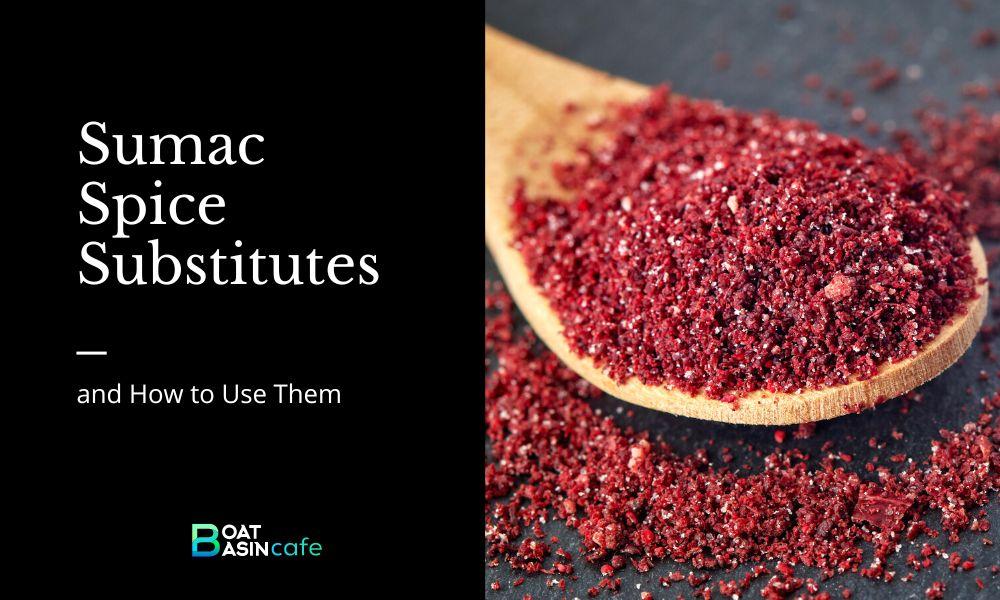Picture yourself cooking a meal for guests when you suddenly run out of your favorite spice. That’s exactly what happened to me last week with sumac spice. As I scrambled to decide what to do next, I researched substitutes and found several useful options.
This list not only offers 10 sumac substitutes but also provides an accurate description of what sumac spice tastes like to help you choose the best alternative.

What is Sumac Spice and Why Substitute It?
Sumac spice is a popular seasoning in Middle Eastern and Mediterranean cuisines, known for its tangy and lemony flavor. It is made from the dried and ground berries of the sumac shrub, which grows in the Mediterranean and Middle Eastern regions. Sumac spice is a versatile ingredient that can be used to add flavor to a variety of dishes, including salads, marinades, and meat rubs.
However, there may be situations where you need to substitute sumac spice in a recipe. One reason for substituting sumac spice is that it may not be available in your local grocery store. It is also possible that you may have an allergy to sumac or a dietary restriction that prevents you from using it in your cooking.
Fortunately, there are several substitutes for sumac spice that can provide a similar flavor profile. These substitutes include lemon zest, vinegar, tamarind powder, za’atar, amchur powder, citric acid, lime juice, pomegranate molasses, sour salt, and orange zest. Each of these substitutes has its own unique flavor profile, so it is important to choose the one that best fits the recipe you are making.
When substituting sumac spice, it is important to consider the texture and appearance of the substitute. Some substitutes, like vinegar or lemon zest, may change the texture of the dish, while others, like citric acid or sour salt, can be used in small amounts to maintain the original texture. Additionally, you will want to consider the availability and cost of the substitute, as some substitutes may be more difficult to find or more expensive than others.
10 best sumac spice substitutes
| Substitute | Flavor Profile | Availability | Quantity to Use |
|---|---|---|---|
| Lemon pepper seasoning | Tangy and slightly sweet | Readily available | Use 1.5x lemon pepper seasoning |
| Za’atar | Complex and unique | Widely used in Middle Eastern cuisine | Same as sumac spice |
| Dry mango powder | Tart and fruity | Commonly used in Indian cuisine | Half the amount of sumac spice |
| Tamarind | Sour | Widely used in Indian and Southeast Asian cuisine | Same as sumac spice |
| Lemon juice | Tangy and acidic | Readily available | Same as sumac spice |
| Sorrel | Sour and lemony | Commonly used in Caribbean cuisine | Half the amount of sumac spice |
| Vinegar | Tangy and acidic | Readily available | Same as sumac spice |
| Horseradish | Pungent and slightly spicy | Readily available | Half the amount of sumac spice |
| Rhubarb | Tart and slightly sweet | Seasonal availability | Same as sumac spice |
| Currant | Tart and fruity | Seasonal availability | Same as sumac spice |
01 Lemon pepper seasoning
Lemon pepper seasoning ticks most boxes when it comes to sumac substitute. It has a sharp, tangy taste and consists of salt and pepper.
Can’t find lemon pepper seasoning in your local store?
Worry not! Add black pepper to dried lemon zest, and you will get something pretty close. An additional advantage is the large amount of Vitamin C in lemon.
✍️ Note: Use 1.5x lemon pepper seasoning compared to sumac for the same intensity.
02 Za’atar
I agree Za’atar is not common, but it is an excellent sumac substitute. It is another middle eastern spice blend that consists of ingredients like
- Salt
- Sesame Seeds
- Dried herbs (oregano, Marjoram, Thyme)
It’s not only tasty but also healthy. The citrus undertones and nuttiness of this blend make it special. The good news is one can use it in the same proportion as sumac.
03 Dry mango powder
Dry mango powder is native to India and is also known as amchoor. Its acidic flavor is similar to sumac. Making this powder is easy.
Step 1: Dry green mangoes in the sun.
Step 2: Grind the mangoes to reduce them to powder form.
That’s it!
It has a more tangy and acidic taste than sumac, and therefore use it in less quantity (approximately half).
04 Tamarind
Tamarind offers you sourness, sweetness, and tartness.
Isn’t that a great combination?
These taste notes resemble sumac closely. It is native to Indian and Thai cuisine but not uncommon in grocery stores globally. One can use it in thick pods or, better still, make a paste that can be virtually added to any recipe.
Because of its intense flavor, only a pinch of tamarind is needed to substitute sumac. The paste can be added to any recipe, but it’s best suited for Indian and Middle Eastern delicacies.
05 Lemon juice
Lemon is the closest alternative to sumac, so it makes a second appearance on this list in another form.
Add fresh lemon juice to your recipe in a similar proportion, and one will get that sourness.
The advantage of lemon juice is you can balance its taste by adding sugar. As for the color, lemon juice won’t add that crimson red; one can add a bit of paprika to the recipe.
06 Sorrel
Sorrel provides the tart flavor of sumac, although it gives dishes a greenish hue instead of red. Use half the amount of sorrel as sumac, as it is more intense and sour. Sorrel is versatile and suitable for sweet and savory recipes.
07 Vinegar
Do not be surprised to find vinegar on this list. Despite being a liquid, it is a sumac alternative because of its acidic tang. Sure enough, you won’t find the floral aftertaste, but it does add the tang. Best of all, it is a regular staple in our homes. One can use vinegar as a seasoning and still get that tang. So, if you are looking for a substitute you can use right now, it is vinegar.
Note:
Add vinegar in small quantities to your delicacy as it can easily overpower the taste notes.
08 Horseradish
How about something less bitter and more pungent?
If that meets your requirement, try horseradish. According to Wikipedia, horseradish is used globally as a condiment and spice that makes it easy to procure. A report also states that it is rich in antioxidants, making it a healthier alternative.
One can crush horseradish and add it to the delicacy. Alternatively, a horseradish sauce is also a great option.
To create such a sauce, follow the steps below.
Step 1: Mix horseradish and yogurt in equal parts by grinding them in a food processor.
Step 2: Add salt and pepper as per preference and mix it again.
Such a sauce can be added to curries or served with chicken. It is undoubtedly a convenient alternative with so many ways to use it.
✍️ Note: If horseradish is too strong, add vinegar or lemon juice to temper its flavor.
09 Rhubarb
Rhubarb is an ideal sumac replacement for sauces or salads due to its sour and tart flavor. Use a cup of chopped rhubarb in place of 1 tablespoon of ground sumac.
However, there are a few caveats when using rhubarb:
- Remove the leaves, as they contain toxins.
- Pair it with classic fruits like strawberries to balance its sourness.
- Cook it until soft, and add sugar to balance the taste, if needed.
One can also add Rhubarb to the dish in the raw form if need be. The similarity in the taste of Rhubarb, coupled with the fact that it is great for bone health, makes it a worthy alternative.
10 Currant
Currant mimics sumac’s berry, sour, and sweet flavor very well. Couple that with the acidity it brings, and it is an easy match. To top it all, they can be used interchangeably in the same measurement. Keep in mind it is a vitamin powerhouse and improves immunization power.
Recipes that taste great with Sumac spice substitutes
While you can use these substitutes in many recipes, some of the safest options are:
- Baked Fries
- Grilled Eggplant
- Yogurt Sauce/Dips
How to Choose the Best Sumac Spice Substitute for Your Recipe

Choose a substitute based on the recipe
Don’t be overwhelmed by the 10 options. Simply choose one according to your recipe. For instance, if you’re making a salad, marinade, or curry, go with a liquid like lemon juice or vinegar; otherwise, choose a powdered or dry substitute.
Use the appropriate quantity
Sumac and its substitutes can overpower a dish if used excessively. Each substitute listed above includes a suggested quantity relative to sumac. Add the specified amount or less – you can always add more, but you can’t remove what’s already in the dish.
Flavor Profile
Sumac spice is known for its tangy and lemony flavor, so it is important to choose a substitute that will replicate this taste. Lemon zest, vinegar, tamarind powder, and citric acid are all good substitutes for sumac spice, as they have a similar tangy and acidic taste.
Texture and Appearance
Sumac spice has a slightly grainy texture and a reddish-brown color. When choosing a substitute, it is important to consider how it will affect the texture and appearance of your dish. Some substitutes, like vinegar or lemon juice, may change the texture of the dish, while others, like citric acid or sour salt, can be used in small amounts to maintain the original texture.
Availability and Cost
Some substitutes for sumac spice may be more readily available or affordable than others. For example, lemon zest can be easily obtained by grating the peel of a fresh lemon, while pomegranate molasses may be harder to find and more expensive. Consider the availability and cost of the substitute when making your choice.
Store substitutes away from direct sunlight
Whether it’s vinegar or tamarind, direct sunlight can reduce potency. Most substitutes are spices that lose flavor and aroma when exposed to sunlight, so store them in cool, dry places.
FAQs
Is sumac similar to paprika?
Sumac’s crimson-red color is similar to paprika, but their tastes differ, which is why paprika isn’t listed as a substitute above.
Is sumac similar to turmeric?
No, sumac isn’t similar to turmeric. Sumac has a tangy, tart taste closer to lemon zest, while turmeric has a pungent, almost bitter flavor.
Are liquid sumac spice substitutes better?
Liquid sumac spice substitutes are easier to use, but solid or powdered ones often provide better taste notes. Choose between them based on your preference for convenience or taste.
Conclusion
Don’t worry if you can’t find sumac. Simply choose one of these 10 sumac spice substitutes, and your dish will taste just as good, if not better.








